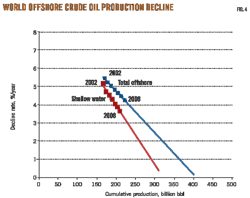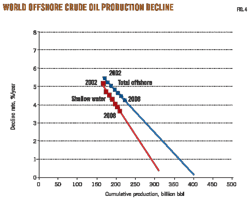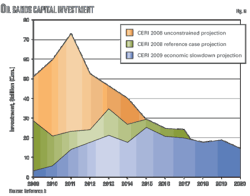Development constraints limit Turkmen gas export options
Constraints in project financing and technical capabilities in developing its gas fields, as well as a lack of adequate gas infrastructure, will limit gas export availability from Turkmenistan for new potential customers such as Europe for the next 5 to 10 years as the country instead focuses on boosting exports to existing customers such as China and Iran.
Turkmenistan holds the world's fourth largest natural gas reserves, after Russia, Iran, and Qatar. The country's gas reserves increased most recently after discovery of supergiant South Yolotan field in 2006. Turkmenistan's natural gas reserves currently measure roughly 265 tcf (OGJ, Dec. 21, 2009, p. 18).
Turkmenistan's large reserves give it an increasingly important role as an exporter in international gas markets, particularly to the Middle East and Asia. The inauguration of new export pipelines from Turkmenistan to Iran and China has reinforced this role.
Iran
Turkmenistan agreed in July 2009 to increase gas exports to Iran, to roughly 1.4 bcfd from previous contractual volumes of 800 MMcfd. Iran completed construction in December 2009 of a 48‐in. OD, 35 km pipeline connecting Turkmenistan's Dauletabad field and Iran's Hasheminejad gas processing plant to import the additional 580 MMcfd of Turkmen gas.
Iran plans to extend the new import pipeline from the Hasheminejad plant to Sangbast, 40 km southeast of Mashhad city. Construction of the new 48‐in. OD pipeline will begin this year and may take as much as 2 years to complete. The pipeline will be 120 km long and will enhance the Iranian gas network's ability to absorb additional volumes of Turkmen gas.
FACTS Global Energy's base-case scenario expects Turkmenistan's gas exports to Iran to average 0.9 bcfd in 2010, reaching 1.3-1.4 bcfd from 2012 onward.
Turkmenistan started gas exports to Iran in 1997 when it completed the 40‐in. OD pipeline from Korpedzhe (Turkmenistan) to Kurd Kui (Iran). This pipeline could export 1.4 bcfd if more compressor stations are installed. The pipeline currently supplies contractual gas volumes (800 MMcfd) committed by Turkmenistan in its initial 1995 agreement with Iran.
These exports have not increased to agreed annual levels (Fig. 1) but did reach 600-800 MMcfd in winter 2009-10 when Iran faced gas shortages in the northeastern portion of the country. At the same time, however, Turkmenistan has shown a willingness to suspend shipments altogether when necessary, most recently for more than 3 months in early 2008 when Iran was experiencing a gas shortage and Turkmenistan sought a price hike to $3.90/MMbtu from $2.10/MMbtu.
Turkmenistan raised prices again for 2009. The Iranian government tried to avoid another supply cut and accepted a temporary price for first-half 2009 of $9.80/MMbtu for Turkmen gas imports. Iran agreed in July 2009 to pay Turkmenistan on an oil-linked price formula and increase imports to 1.4 bcfd. The formula uses a basket price of gasoil, low sulfur, and high-sulfur fuel oil prices and translates to roughly $6.10/MMbtu at current petroleum product prices.
Turkmenistan-China pipeline
Construction of the first of two parallel 42-in. OD gas pipelines from Turkmenistan to China through Uzbekistan and Kazakhstan finished in November 2009, with the second line under construction for completion in 2011-12.
The Turkmenistan-China gas pipeline measures about 1,833 km (188 km in Turkmenistan, 530 km in Uzbekistan, and 1,115 km in Kazakhstan), connecting the Bagtyyarlyk, Saman-Depe, and Altyn Asyr gas fields in Turkmenistan to Alashankou in China's Xinjiang province, where the pipeline connects to China's partially completed Second West-East Gas Pipeline.
Capacity of the first export line is about 1.9 bcfd, and the second pipeline will increase China's import capacity from Central Asia to nearly 3.9 bcfd. It is likely, however, that actual throughput will be lower 2010-12 as FGE expects gas demand in Xinjiang to be less than pipeline capacity. FGE predicts Turkmen gas exports to China will average 0.5 bcfd in 2010.
Completion of China's second West-East gas pipeline, however, from Xinjiang to Shanghai will help China absorb more Turkmen gas.
FGE's base case forecast calls for Turkmen gas export volumes to China to increase to 1.5 bcfd in 2012 and 2.9 bcfd in 2015. Under the high-case scenario, gas supply to China would reach 3.9 bcfd after 2015.
The Turkmen gas price for China is based on an oil-linked pricing formula, equaling roughly $5.50/MMbtu at a crude price of $90/bbl. The at-border price for Turkmen gas sold into China then, including a transmission fee of $2.40/MMbtu through Uzbekistan and Kazakhstan, is roughly $7.90/MMbtu.
Russia
Russia's Gazprom remains the largest buyer of Turkmen gas, buying 4.5 bcfd in 2008.
Gazprom had agreed to a 25-year sales and purchase contract with Turkmenistan to increase gas imports to 5.8 bcfd in 2009 and 8.7 bcfd from 2010 onward but proved unable to implement the agreement, stopping imports of Turkmen gas in second-quarter 2009 mainly due to falling demand in Russia and Europe. A pipeline explosion in April 2009 also constrained imports, which totaled only 1.1 bcfd in 2009.
Turkmenistan agreed with Russia in December 2009 to resume gas supplies from January 2010, with delivery of up to 2.9 bcfd of gas planned to Russia in 2010.
Turkmenistan's eventually boosting gas exports to Russia to 8-9 bcfd depends in large part on completion of the Pre-Caspian Gas Pipeline. The 1,700-km line will allow Gazprom to import up to 2.9 bcfd from Turkmenistan. The pipeline, however, is unlikely to be onstream before 2014-15.
Gazprom purchases Turkmen gas based on a pricing formula linked to a basket of petroleum products, estimated to equal $6.20-7.00/MMbtu for 2010. The price of Turkmen gas to Gazprom has been rising steadily since the 2004 price of $1.10/MMbtu price.
A domino effect in gas prices occurs when Gazprom sells gas to Europe at high prices: Turkmenistan asks for European netback prices for its delivered gas to Russia and Gazprom in turn accepts it. This results in Turkmenistan setting similar gas prices for its contracts with Iran and China.
Gazprom usually accepts high Turkmen gas prices since it resells the volumes with a premium to Europe. Gazprom is in fact eager to import as much Turkem gas as infrastructure allows, resulting in potentially constrained exports from Turkmenistan to other markets.
Export availability
Turkmenistan's Osman-South Yolotan holds 212 tcf of recoverable gas. At least seven development phases, each producing about 2.9 bcfd, are possible in South Yolotan, meaning a potential future production rate of 20 bcfd. The Dauletabad and Bagtyyarlyk areas also contain large gas reserves, around 80 tcf combined.
Turkmenistan, however, struggles with a lack of financial resources and technical capability in developing new gas projects. The country also faces limited export infrastructure. Considering these constraints, it is unlikely Turkmenistan will increase gas export volumes to more than 11.1 bcfd in the next 10 years.
FGE's base case forecasts Turkmenistan exports of roughly 9.1 bcfd in 2015 (including 4.8 bcfd to Russia, 2.9 bcfd to China, and 1.4 bcfd to Iran). Turkmen gas exports will increase to 11.1 bcfd in 2020, with more going to both Russia and China.
Proposed pipeline projects such as the Trans-Caspian Gas Pipeline (running through the Caspian Sea, Azerbaijan, and Georgia to Europe, bypassing Russia) are unlikely to materialize before the end of this decade, considering their costs and technical difficulties. The Trans-Caspian pipeline also requires a legal framework not yet in place and consent of the Caspian littoral states, neither of which is expected to be a quick process.
Foreign involvement
Russian and Chinese companies dominate key gas projects in Turkmenistan, exerting political influence while providing the technical capabilities needed to develop large, complex gas projects.
• CNPC in South Yolotan. China National Petroleum Corp. is involved in developing South Yolotan. State Turkmengaz signed a $9.7 billion contract in December 2009 for development of the field with several companies including CNPC, Gulf Oil & Gas Fze (UAE), Petrofac International LLC (UAE), and a consortium of LG International Corp. and Hyundai Engineering Co. Ltd (Korea).
Gulf Oil & Gas Fze is to drill wells producing 1.9 bcfd. CNPC will drill wells and design and construct downstream facilities producing 1.0 bcfd of gas. Petrofac International LLC, LG International Corp. and Hyundai Engineering Co. Ltd will design and construct gas sweetening facilities.
• CNPC in Bagtyyarlyk. CNPC and Turkmenistan signed a 30-year production sharing agreement in July 2007 for exploration and production of the large Bagtyyarlyk gas field. Gas from this area will fulfill part of Turkmenistan's supply commitment to China.
• ITERA, Zarubezhneft in Block 21. Russian companies ITERA and Zarubezhneft signed a PSA in September 2009 for development of offshore Block 21 in Turkmen waters in the Caspian Sea. Block 21 holds 1.1 billion bbl recoverable oil and 2.1 tcf associated gas reserves. Zarubezhneft owns a 51% share, while ITERA holds the balance.
Export outlook
Turkmenistan's role in supplying gas to China and Iran will grow this decade. China will meet 4.6% of its natural gas demand with Turkmen supplies in 2010, increasing to nearly 15.4% in 2015.
Iran will also depend heavily on Turkmen gas imports during 2010-15, with almost all new Iranian gas projects, especially in South Pars, delayed.
The high dependency on Turkmen gas in China and Iran will allow Turkmenistan to set a price in line with European market prices for these countries as well. High-priced Turkmenistan gas will signal other Central Asian gas producers such as Uzbekistan and Kazakhstan to expect higher value for their gas in Asia as well, prompting them to set higher gas prices on any potential export projects. ✦
The author
More Oil & Gas Journal Current Issue Articles
More Oil & Gas Journal Archives Issue Articles
View Oil and Gas Articles on PennEnergy.com



